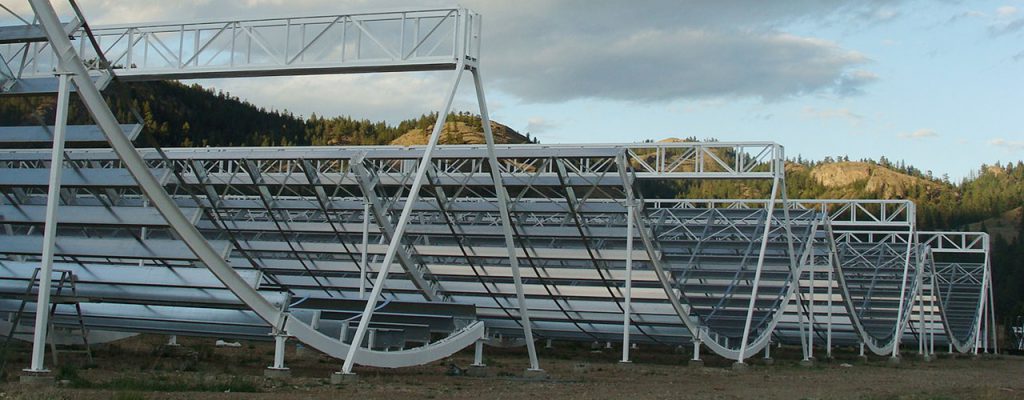By: Cynthia Macdonald
12 Oct, 2018

Was it a collapsing star, two black holes merging, or something else entirely? Astronomers aren’t exactly sure what caused the fast radio burst picked up on July 25 by the CHIME radio telescope near Penticton, B.C. But they are confident about CHIME’s ability to detect these mysterious and transient flashes, which can tell us a great deal about what’s happening in galaxies far outside our own.
Fast radio bursts (FRBs) last only for a few thousandths of a second, but are said to emit the energy of 500 million suns. The first was discovered in Australia eleven years ago, and since then almost three dozen others have been recorded at observatories around the world. The CHIME burst was recorded at the lowest frequency to date.
CHIME stands for the Canadian Hydrogen Intensity Mapping Experiment; as its name would suggest, the telescope wasn’t originally designed for picking up FRBs. Surveying more than half the sky as the earth turns on its axis, CHIME’s first job was to help astronomers create a three-dimensional map of the largest volume of space ever surveyed.
During its construction, however, astrophysicists realized that it might also be very well-suited to recording low-frequency FRBs, and had a special antenna installed to do just that. Says McGill’s Victoria Kaspi, Director of CIFAR’s Gravity & the Extreme Universe program: “some said CHIME wouldn’t be able to detect these particular FRBs, because at a low frequency the signal vanishes. But now we know it can.”
The telescope’s unique structure is part of what makes it versatile, says UBC cosmologist Gary Hinshaw, CIFAR Senior Fellow and another member of the CHIME team. With no moving parts or round dishes, CHIME calls to mind the half-pipes of a B.C. snowboard park. “That shape gives us an enormous footprint on the sky, so we can observe these flashes,” says Hinshaw.
By the time it is fully operational – which may not be for a year or two – CHIME could well detect as many as two dozen FRBs per day. Kaspi cautions that there is still great uncertainty around the rate, “but it’s definitely not zero, and that’s why we’re very excited,” she says.
Where the origin of FRBs is concerned, astronomers like to joke that there are more theories than possible causes. Only one FRB has ever repeated, and Kaspi was a member of the team that discovered it in 2012. That repetition provides a clue as to its origin: Kaspi says that “we know that if a flash repeats, you know that colliding neutron stars aren’t causing it.”
And yet star collisions could cause FRBs – just not in that particular case. In fact, FRBs might be set in motion by many different events taking place across the violent, roiling expanse of the universe. There is one very popular theory, however, that Kaspi definitely rules out: extraterrestrial intelligence.
“It’s not possible,” she says emphatically. “How could one civilization communicate with another one – which just happens to have the same technology they do – in a completely different part of the universe?”
Back on earth, however, communication between astronomers located in various parts of the world has never been better. This is the era of multimessenger astronomy, where data can come from a variety of sources. Information concerning gravitational waves, neutrinos, fast radio bursts and other phenomena all strengthens general understanding of the universe. Now, says Kaspi, “we could detect an FRB at the same time as a gravitational wave event, which would be just spectacular.”
CIFAR played a big part in the formation of CHIME, for which we’re very grateful and excited. Many of the ideas for it were born out of CIFAR meetings.
CHIME is a $16 million project funded jointly the federal government and the governments of Quebec, Ontario and British Columbia, with additional funding from NSERC and CIFAR. In addition to Kaspi and Hinshaw, several other Gravity & the Extreme Universe program members are involved with the project, including Matt Dobbs (McGill); Mark Halpern and Ingrid Stairs (UBC); Ue-Li Pen (Toronto); and Scott Ransom (National Radio Astronomy Observatory).
“CIFAR played a big part in the formation of CHIME, for which we’re very grateful and excited,” Hinshaw says. “Many of the ideas for it were born out of CIFAR meetings. So go Canada – and go CIFAR. It’s been a wonderful partnership.”